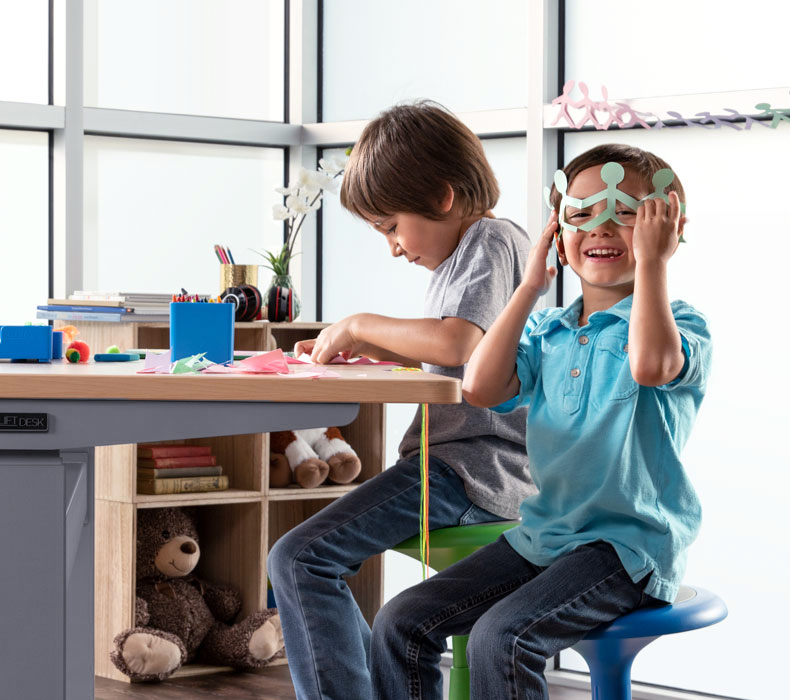
Back to school with ergonomic furniture for kids: Better health, better learning
The impact of ergonomics on student health and academic performance
With a new school year fast approaching, essentials like backpacks, binders, new clothes, pens, pencils, and tech are flying off the shelves—but often overlooked is ergonomic furniture. Proper ergonomic furniture for students can significantly impact health, focus, and the overall learning experience.
The basics of ergonomics for kids

Ergonomics, the science of designing environments to fit the user’s needs, plays a vital role in creating a comfortable and productive study space for children. Proper ergonomic design helps prevent discomfort, promote good posture, and reduce the risk of musculoskeletal issues. For kids, ergonomic furniture means desks and chairs that can be adjusted to fit their growing bodies, ensuring they can study without unnecessary strain, and learning environments that encourage movement to channel all that energy into something positive. Ultimately, this benefits both the health and academic success of students.
Health benefits of ergonomic furniture for growing students
The health benefits of ergonomic furniture for kids are well documented:
- Improved posture: Ergonomic desks and chairs support proper spine alignment, crucial for growing children, preventing poor posture habits that lead to back and neck pain.
- Reduced discomfort: Adjustable furniture ensures kids maintain a comfortable position while studying, leading to better focus and longer concentration periods.
- Prevention of musculoskeletal issues: Ergonomic furniture helps prevent musculoskeletal disorders caused by prolonged periods of sitting in non-ergonomic positions. It also promotes movement between postures, perfect for those high-energy growing bodies.
Time and again, studies show that students using ergonomic furniture experience fewer instances of back pain and discomfort, leading to a host of other benefits.
Academic benefits of ergonomic furniture for growing students
Beyond physical health, ergonomic furniture positively impacts academic performance. Comfortable and well designed furniture can lead to:
- Increased productivity: Comfortable students are more likely to stay focused on tasks. Focus means efficiency, and efficiency means less time spent on homework and more time for enriching activities (i.e., fun).
- Enhanced engagement: When children aren't distracted by physical discomfort or forced to sit still, they're more engaged in their learning activities. This engagement can lead to increased participation and improved academic outcomes.
- Improved cognitive performance: Studies show that the use of standing desks and other ergonomic furniture can enhance cognitive functions such as memory and problem-solving skills. This is credited to increased blood flow and oxygen to the brain that results from using ergonomic furniture and moving more.
Incorporating movement into the classroom, such as using standing desks, has also been shown to benefit students' cognitive functions. According to an article from Education Week, allowing children to move while they learn can improve focus and memory retention, leading to better academic performance.
Ergonomic furniture options for kids
When selecting ergonomic furniture for your child, it’s important to consider a few key features. Here are some recommendations that cater to the ergonomic needs of children:
- With the UPLIFT Standing Desk, kids can easily switch between sitting and standing positions, promoting better posture and reducing the risk of musculoskeletal issues. It's also a desk that grows along with young students, meaning that there's no hunching over after a growth spurt or need for seat boosters as you wait for them to grow into it. Choose a whiteboard desktop and pick up some dry-erase markers for a creativity-encouraging, height adjustable canvas.
- An UPLIFT Height Adjustable Craft Table provides plenty of built-in storage and ample space for activities and homework alike. Three spacious drawers and two large compartments with hinged lids gobble up school and art supplies.
- Our Kids Active Stool encourages movement and flexibility, allowing children to stay engaged and focused while they study. The stool's design promotes healthy posture and provides a dynamic seating option.
- The E7 Small Active Anti-Fatigue Mat provides a comfortable surface for children to stand on while using a standing desk, reducing fatigue and encouraging movement.
- Add more fun and movement with the Bamboo Motion-X Board, which promotes posture and balance while providing an outlet for that unending energy.
And don't just take our word for it—check out the glowing reviews of these products from happy parents and customers, like this one on the Kids Active Stool: "Being able to wobble around really helped my son handle the challenges of online learning while he's stuck in front of a screen. Zero assembly and good quality. They should put these things in schools!"

Ergonomics for lifelong learning and beyond
Investing in ergonomic furniture for kids is an investment in their health, comfort, and academic success. Creating an ergonomic study environment can make a significant difference in the lives of students, supporting physical and cognitive development, better health, and better learning for years to come.
While we've focused on young learners, these benefits extend to teenagers, college students, and adults in the workplace, as well. Everyone can benefit from the improved posture, reduced discomfort, and enhanced cognitive performance that ergonomic furniture provides. Invest in success and a brighter, healthier future with UPLIFT Desk.
Sources
Ergonomics For Children In The Classroom In 2023
Ergonomics for Students and Staff | Oxford Academics
Ergonomic School Furniture: Enhancing Student Comfort and Productivity
Learning in Motion: Bring Movement Back to the Classroom (Opinion) | EdWeek
Investigating the impact of flexible furniture in the elementary classroom | Learning Environments Research
Standing Up at Your Desk Could Make You Smarter - The New York Times
Standing Up for Learning: A Pilot Investigation on the Neurocognitive Benefits of Stand-Biased School Desks